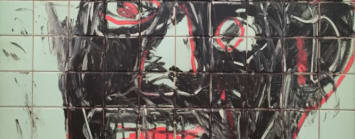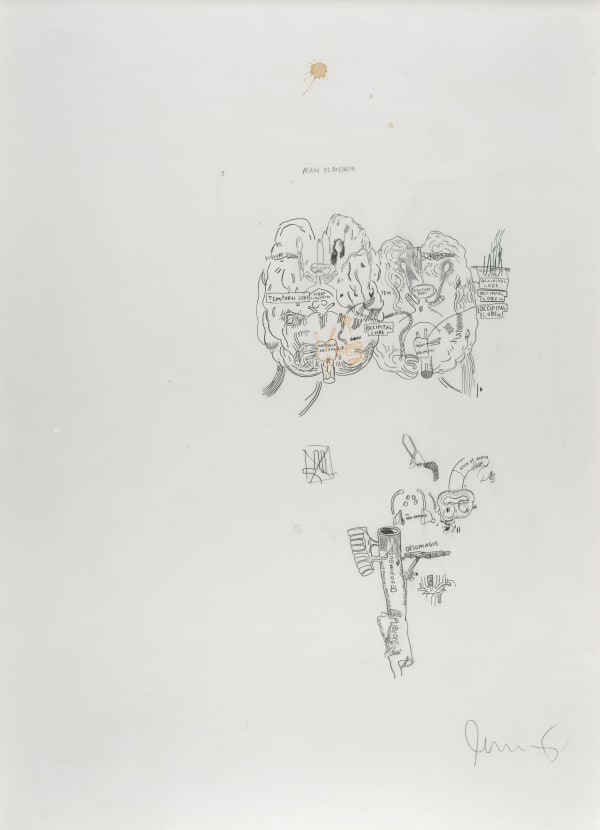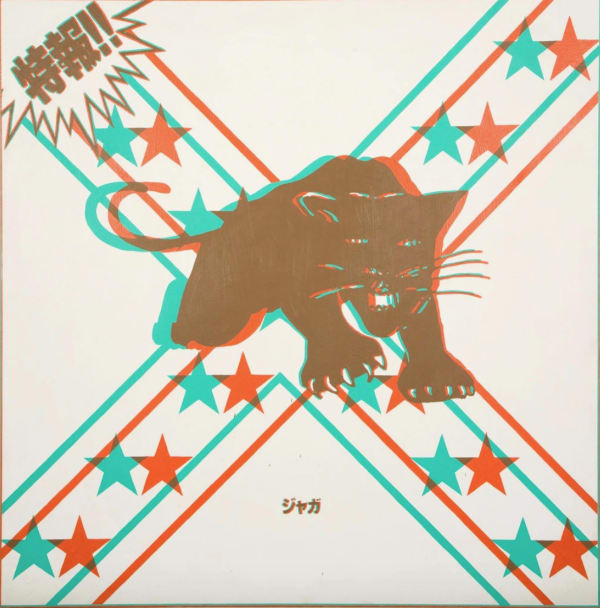Doing a show about the New York City art scene of the 80s had been on our mind for a long, long time. Exciting art movements seem to come about every 40 or so years: The first decade of the 20th century saw Modernism take shape in Paris, the Abstract Expressionist movement of post World War II New York put American painting on the international radar for the first time, and some 40 years ago, New York saw another radical change take place. Timing couldn't have been better when the below hit our inbox on June 7, 2020:
Newsletter Signup Confirmation: Brett De Palma
We were flabbergasted. Could this possibly be the Brett De Palma we came across when researching the 1980's downtown art scene in New York City? The same Brett De Palma that Jean-Michel Basquiat so famously depicted in his 1982 work Brett As A Negro?
Emails were exchanged, the plan for this exhibition was born and Brett was so kind to not only contribute some very exciting works of art to this exhibition but also write the introduction:
-
THE SIGN FORWARD
by Brett De PalmaWhen I first saw the PULPOGALLERY.com logo, I thought how interestingly it combined the expressive splash with parallel lines in a graphic symbol, echoing two main thoughts of contemporary art. When I saw they were offering work by Jean-Michel Basquiat and Baselitz, I thought they are tuned to two of my favorite important artists!
In 1978, when I first arrived in the international port city of Manhattan, after waiting tables on the likes of Robert DeNiro, I quickly landed a job at a blue chip SoHo gallery, Sperone-Westwater-Fischer. As a gallery manager, I quickly learned WWII contemporary art by meeting German and Italian artists, the likes of Gerhard Richter and Chia, Cucci, Clemente.
In 1979, after work, I painted at home and produced a body of paintings that I shared as a set of slides with a German sculptor who came for a studio visit. Unbeknownst to me, he had connections, and the next thing I knew, I received an invitation to show in Documenta 7.
-
Brett De Palma
Selected Works -
Meanwhile, by 1980, I had joined the downtown New York underground by frequenting clubs, where I met other artists who were all part of a community beginning to take matters into their own hands and show work outside of the SoHo art center. I saw writing on the walls by someone tagged as “Samo.” I was invited by friend Diego Cortez, to show in New York - New Wave, 1981, with one hundred other artists of my sensibility. During the installation, Diego came and said, “Someone wants to meet you.” He took me to a young black artist and said, “This is Samo.” Basquiat said to me, “You do anatomy? I do anatomy too.” This began a long friendship that changed my life!
-
Jean-Michel Basquiat
Selected Works -
Meanwhile, in 1981, back at work one day, in walked Keith Haring, who I knew from the club scene, and he said, “I work for this guy, Tony Shafrazi, and he’s starting a gallery, and I think you should be in it.....” I said, “Yes!” At the same time, I was introduced through Chia, Cucci, Clemente to the Italian dealer, Emilio Mazzoli, who invited me to show in Modena, Italy, the month after Basquiat. All of this happened at once! My head was spinning and hasn’t stopped.
To make a long story short, I have taught painting and drawing from Princeton University to School of Visual Arts in NYC for over thirty years, while having an art career like a roller coaster, while I have learned not to be fooled by the highs and lows, but to pay attention to the road signs.
So, when I see PULPOGALLERY.com online, I pay attention, and read it as the way forward, and I follow the lead of fellow-in-the-know, artists, gallerists, and collectors.
- Brett DePalma
-
New York's Art Scene in the 80s
Another contemporary we spoke to is Michael Holman, an artist, writer, musician, theatre director and filmmaker. Michael is not just a pioneer of the downtown New York Art Scene but has also been a driving force in the uptown hip hop movement, a term first used in print by him (East Village Eye, January 1982). In addition, Holman was responsible for Negril, Downtown New York's first Hip Hop nightclub as well as Graffiti Rock, the first Hip Hop television show which he created, hosted and produced.
Michael is perhaps best known as the screenwriter of the film Basquiat, which was directed by Julian Schnabel and released by Miramax.
-
Basquiat (1996)
Directed by: Julian Schnabel
Produced by: Joseph Allen, Peter Brant
Screenplay by: Julian Schnabel, Michael Holman
Story by: John Bowe, Michael Holman, Lech Majewski
Cast: Jeffrey Wright as Jean-Michel Basquiat, David Bowie as Andy Warhol, Benicio del Toro as Benny Dalmau, Dennis Hopper as Bruno Bischofberger, Gary Oldman as Albert Milo, Claire Forlani as Gina Cardinale, Courtney Love as Big Pink, Tatum O'Neal as Cynthia Kruger, Christopher Walken as The Interviewer, Willem Dafoe as the Electrician
-
When Downtown New York City saw the birth of industrial sound-band Gray in 1979, Michael was one of the founding members alongside Jean-Michel Basquiat. Named after Gray's Anatomy, the book was the source not just for their music but also for so many of Jean-Michel's drawings and paintings that revisit the subject of human anatomy over and over again.
Asked about New York City in the 80s, Michael summed it up perfectly:
“It was the zenith of our own Belle Epoch. One hundred years from now, that time will be compared to the Italian Renaissance and every other Belle Epoch the world has experienced.”The contemporary art scene of New York City in the early 80s was a booming business and SoHo was its epicenter. Legendary dealers such as Leo Castelli, his ex-wife Ileana Sonnabend and Mary Boone were demanding large sums of money for young painters like David Salle or Julian Schnabel, both labeled as Neo-Expressionists.
Only a few blocks away another art movement started taking shape. The East Village saw a more conceptual and anti-commercial art scene where many of the former graffiti artists like Jean-Michel Basquiat, Keith Haring and Kenny Scharf had early shows before attracting attention from the SoHo gallerists. Some notable early East Village galleries include the Fun Gallery (opened by Patti Astor and Bill stelling in 1981), International With Monument, or Cash/Newhouse.
-
Michael Holman
-
New York/New Wave
It was February 15, 1981 when the P.S.1, Institute for Art and Urban Resources (now the MoMA PS1) launched the legendary group exhibition New York/New Wave. Featuring more than 100 artists, the portrait of the underground art and post-punk scene of New York City drew huge crowds.Dubbed “The New Wave”, this new cultural movement was founded by a group of creatives from music, film, performance and art. In these years of rebellion and experimentation this artistic freedom started to spill over from the streets into the galleries of New York.Inspired by the 1980 “Times Square Show”, which the Village Voice called “the first radical art show of the eighties”, New York/New Wave was curated by Diego Cortez, co-founder of the Mudd Club, a second home to Lower Manhattan’s underground scene. Initially conceived as a disco for punks and an antithesis of the uptown chic, it soon started to also function as a gallery exhibiting works by Jean-Michel Basquiat and Keith Haring with the latter one soon acting as its director for Mudd Club shows. -
 By Wickkey - Taken with my own camera., CC BY-SA 3.0
By Wickkey - Taken with my own camera., CC BY-SA 3.0 -
Judy Rifka
One of the artists that not only took part in the groundbreaking “Times Square Show” but also showed at The Mudd Club is Judy Rifka (b. 1945). In a 2014 interview Rifka said that she
"felt isolated in the 1970s formalist work. I started getting out more and wanting to be part of the incredible life of that time. People were showing art at night. I wanted to bring my art into the world, and I did that, showing videos in nightclubs. Age-wise I’m always straddling the fence: I’m the youngest one of the 1970s generation and the oldest one of the 1980s generation. I was friendly with Keith Haring and René Ricard at the time.”
After participating in two Whitney Museum Biennials in 1975 and 1983 as well as Documenta 7, Rifka was immortalized in René Ricard’s infamous “The Radiant Child” article for Art Forum:
"We are that radiant child and have spent our lives defending that little baby, constructing an adult around it to protect it from the unlisted signals of forces we have no control over. We are that little baby, the radiant child, and our name, what we are to become, is outside us and we must become "Judy Rifka" or "Jean-Michel" the way I became "Rene Ricard.”"
-
-
George Condo
Another artist whose rise to fame is closely related to The Mudd Club is George Condo (b. 1957) whose chance encounter with Jean-Michel Basquiat prompted his move from Boston to New York City:
"We went to New York to play their [The Girls] first gig there in 1980, I think, or ’79. At this one club our band was playing together with Jean-Michel Basquiat’s band, so it was a double bill. He was Gray, and we were The Girls. That was the name of the band: The Girls. It was this really comical, hysterical, electronic punk. Really crazy art punk. We played with Gray. They were a bit serious. ... They were not so great. They were just making sounds. They opened for us. We were the main act. And so at that point, I met Basquiat. He said “Hi,” and I said, “I’m from Boston. I don’t know anything about New York.” So he took me to the Mudd Club after the show, and I loved hanging around in that place, and then we played the second night. I think we had two nights, Friday and Saturday."
Subsequently, Condo moved to Ludlow Street in New York City, became a founding member of the punk/blues band “Hi Sheriffs of Blue” and emerged as one of the stars of the East Village art scene of the early 1980s. Condo, Basquiat and Haring were instrumental in the international revival of painting and his take on European Old Master paintings was soon coined “Artificial Realism”.
-
















